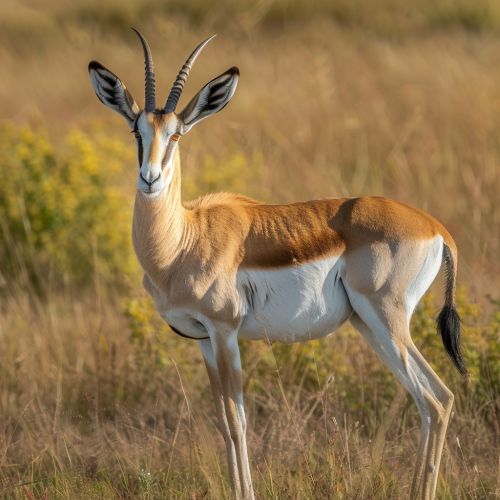Springboks
Taxonomy and Evolution
The Springbok (Antidorcas marsupialis) is a medium-sized antelope found mainly in southern and southwestern Africa. The name "Springbok" comes from the Afrikaans and Dutch words "spring" (jump) and "bok" (antelope or goat), which accurately describes the animal's characteristic jumping display, known as pronking or stotting. The scientific name, Antidorcas marsupialis, refers to the unique, pocket-like skin flap that extends along the middle of the back from the tail onwards.
Springboks are part of the Bovidae family, which includes other well-known African species such as the African Buffalo (Syncerus caffer) and the Impala (Aepyceros melampus). They are the only species in the genus Antidorcas, but are closely related to the gazelles (Gazella) and the true antelopes (Antilopinae).
The evolution of the Springbok is a subject of ongoing research, but it is believed to have diverged from its closest relatives approximately 3 million years ago, during the late Pliocene or early Pleistocene. This divergence was likely driven by changes in the African climate, which led to the expansion of grasslands and the evolution of new grazing species.


Description
Springboks are medium-sized antelopes, standing 70 to 87 cm (28 to 34 in) at the shoulder. Males, or rams, are slightly larger than females, or ewes, and can weigh up to 50 kg (110 lb), while females typically weigh 37–44 kg (82–97 lb). Both sexes have a pair of black, lyre-shaped horns, which are longer in males (35–50 cm or 14–20 in) than in females (25–33 cm or 10–13 in).
The Springbok has a distinctive coat, with a white face and underbelly, a dark brown stripe running from the eyes to the mouth, and a light brown or grey-brown upper body. The most distinctive feature, however, is the fan-like crest of white hair that runs from the tail to the middle of the back. This crest is usually folded down, but can be erected in times of excitement or distress.
Behavior and Ecology
Springboks are primarily diurnal (active during the day), although they may also be active during the night in hot weather. They are known for their agility and speed, and can reach speeds of up to 88 km/h (55 mph) and leap 4 m (13 ft) through the air when startled – a behavior known as pronking or stotting.
Springboks live in mixed-sex herds of up to 100 individuals during the wet season, but may form much larger herds – up to several thousand individuals – in the dry season, when food is scarce. They are primarily grazers, feeding on grasses, but will also eat leaves, shrubs, and succulents when grass is scarce.
Springboks have few natural predators, but may be hunted by lions (Panthera leo), cheetahs (Acinonyx jubatus), and African wild dogs (Lycaon pictus). They are also susceptible to diseases such as foot-and-mouth disease and Rift Valley fever.
Reproduction
Springbok mating season occurs once a year, usually in the dry season. Males compete for access to females by fighting with their horns and displaying their strength and fitness through high leaps and loud vocalizations.
Females give birth to a single calf after a gestation period of about 168 days. The newborn calf is able to stand and run within a few minutes of birth, but will usually remain hidden in vegetation for a few days until it is strong enough to join the herd.
Conservation
Springboks are listed as Least Concern on the IUCN Red List, thanks to their large population and wide distribution. However, they face threats from habitat loss due to agriculture and hunting for their meat and hides. Conservation efforts are focused on maintaining their habitat and preventing overhunting.
Cultural Significance
The Springbok is an important symbol in South Africa and has been adopted as the national animal. It is also the name of the South African national rugby team, the Springboks, and appears on the South African coat of arms.
